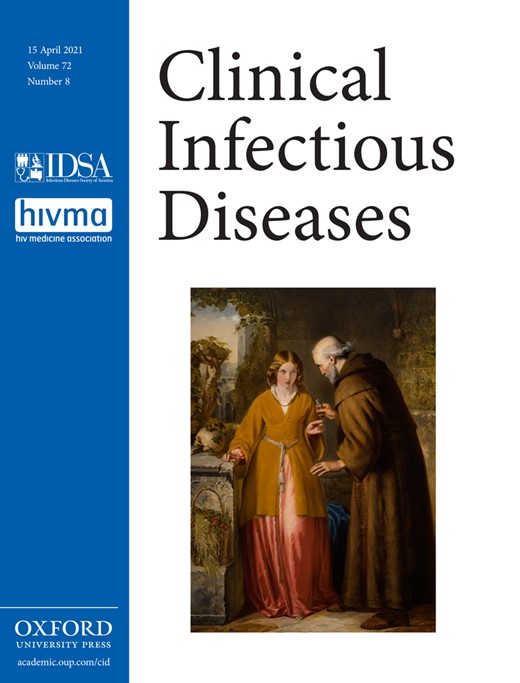
Cover image

Volume 72, Issue 8, 15 April 2021
IN THE LITERATURE
In the Literature
MAJOR ARTICLES AND COMMENTARIES
The Prevalence and Burden of Non-AIDS Comorbidities Among Women Living With or at Risk for Human Immunodeficiency Virus Infection in the United States
Women living with HIV (WLWH) experienced a greater burden of non-AIDS comorbidities than HIV-seronegative counterparts overall and in certain age groups. Traditional risk factors were commonly associated with multimorbidity and should be prioritized for screening and intervention in aging WLWH.
Bearing the Burden of Non-AIDS Comorbidities: This Is What Women Aging With Human Immunodefiency Virus Look Like
De-escalation of Empiric Antibiotics Following Negative Cultures in Hospitalized Patients With Pneumonia: Rates and Outcomes
Less than 15% of eligible patients with pneumonia had antibiotics de-escalated immediately following negative cultures and de-escalation rates varied widely among hospitals. To adhere to newly published guidelines, hospitals will have to change practice substantially.
Oral Doxycycline Compared to Intravenous Ceftriaxone in the Treatment of Lyme Neuroborreliosis: A Multicenter, Equivalence, Randomized, Open-label Trial
In this study, 210 patients with Lyme neuroborreliosis were randomized to receive either ceftriaxone for 3 weeks or doxycycline for 4 weeks. Patients in both groups improved equally as measured by visual analogue scale after 12 months of follow-up.
Asymptomatic Bacteriuria and Pyuria in Premenopausal Women
In this observational cohort study in 104 women evaluated daily, Escherichia coli Asymptomatic Bacteriuria (ASB) (≥105 CFU/mL) occurred on 2.5% of days and rarely persisted beyond 2 days. Pyuria occurred on 25% of days but was poorly predictive of E. coli ASB.
Urinary Tract Infections as a Continuum: Implications for Diagnostic and Antibiotic Stewardship
Hepatotoxicity and Liver-Related Mortality in Women of Childbearing Potential Living With Human Immunodeficiency Virus and High CD4 Cell Counts Initiating Efavirenz-Containing Regimens
Severe hepatotoxicity occurred in 2.5% of women with HIV who initiated efavirenz-containing regimens. Liver-related mortality occurred in 3% of those with severe hepatotoxicity. Older age was predictive of severe hepatotoxicity. Safer antiretroviral therapy regimens are needed in women of childbearing age.
High Incidence of Herpes Zoster After Cord Blood Hematopoietic Cell Transplant Despite Longer Duration of Antiviral Prophylaxis
Cord blood transplant (CBT) recipients have a high cumulative incidence of herpes zoster (HZ) despite longer-term antiviral prophylaxis. Antiviral prophylaxis during immunosuppression and for 3 or more years might reduce the incidence and complications of HZ after CBT.
Transmission of Cryptosporidium Species Among Human and Animal Local Contact Networks in Sub-Saharan Africa: A Multicountry Study
A contact network analysis in 4 countries of sub-Saharan Africa revealed Cryptosporidium neighborhood clusters in rural communities with human-to-human transmission being the predominant transmission route, while zoonotic transmission appears to contribute only marginally.
The Silent Reservoir of Cryptosporidiosis
The Effect of Renal Replacement Therapy and Antibiotic Dose on Antibiotic Concentrations in Critically Ill Patients: Data From the Multinational Sampling Antibiotics in Renal Replacement Therapy Study
In this multinational study of critically ill patients treated with renal replacement therapy (RRT), antibiotic dosing regimens, RRT prescription, and estimated total renal clearance varied markedly and resulted in highly variable antibiotic concentrations that frequently failed to meet therapeutic targets.
Invasive Aspergillosis Due to Aspergillus Section Usti: A Multicenter Retrospective Study
Aspergillus group ustus (section Usti) represents a rare cause of invasive aspergillosis (IA). This retrospective multicenter study reports the epidemiology and outcome of 72 cases of proven/probable IA due to this fungal pathogen.
First Case of Invasive Stachybotrys Sinusitis
This is the first report of invasive Stachybotrys sinusitis in a severely immunocompromised patient with refractory acute lymphocytic leukemia. Tissue invasion by Stachybotrys chlorohalonata was confirmed by histopathology, IHC, and genotyping. The patient was successfully treated, but later succumbed from other causes.
Reinfection Following Successful Direct-acting Antiviral Therapy for Hepatitis C Virus Infection Among People Who Inject Drugs
Among this high-risk population, the overall incidence of reinfection was 3.1 cases/100 person-years, considerably lower than the incidence of primary infection among similar populations. The incidence was elevated among younger people and people who shared needles/syringes.
It’s Not Them, It’s Us: Hepatitis C Reinfection Following Successful Treatment Among People Who Inject Drugs
Impact of an Antibiotic Side-Chain–Based Cross-reactivity Chart Combined With Enhanced Allergy Assessment Processes for Surgical Prophylaxis Antimicrobials in Patients With β-Lactam Allergies
Implementation of an internally developed, cross-reactivity chart for surgical prophylaxis in patients with a documented B-lactam allergy, in combination with enhanced antimicrobial stewardship program, pharmacy, and organizational processes, significantly improved the prescribing of B-lactam antibiotic therapy for surgical prophylaxis.
The Role of Human Immunodeficiency Virus (HIV) Asymptomatic Status When Starting Antiretroviral Therapy on Adherence and Treatment Outcomes and Implications for Test and Treat: The Swiss HIV Cohort Study
People with HIV starting antiretroviral therapy when asymptomatic did as well if not better than symptomatic individuals with respect to adherence and treatment outcomes. This evidence supports differentiated care models focusing resources on vulnerable groups in need of support.
Geographic Shifts in Antibacterial Drug Clinical Trial Enrollment: Implications for Generalizability
In antibacterial drug trials for serious bacterial diseases, changes over time in Eastern European and North American enrollment were observed. Subject demographic, clinical, and microbiologic factors were generally similar among regions, supporting the global generalizability of trial results.
Out-of-Sequence Vaccinations With Measles Vaccine and Diphtheria-Tetanus-Pertussis Vaccine: A Reanalysis of Demographic Surveillance Data From Rural Bangladesh
Diphtheria-tetanus-pertussis (DTP) with or after measles vaccine was associated with two-fold higher mortality than having measles vaccine as last vaccination. DTP after measles vaccine was associated with a strong negative effect for girls, the female-male mortality ratio being 14.83 (1.88-117.1).
A Live-Vaccine-Last Schedule: Saving an Extra Million Lives a Year?
BRIEF REPORTS
Infections in Patients Colonized With Extended-spectrum Beta-Lactamase-Producing Enterobacterales: A Retrospective Cohort Study
Disease Prevention Not Decolonization: A Model for Fecal Microbiota Transplantation in Patients Colonized With Multidrug-resistant Organisms
Microbiome-based Therapies for Multidrug-resistant Pathobionts: Getting a Step Closer!
Community-acquired Coinfection in Coronavirus Disease 2019: A Retrospective Observational Experience
Invasive Disease Potential of Pneumococcal Serotypes in Children After PCV13 Implementation
VIEWPOINTS
Thinking Beyond the “Core” Antibiotic Stewardship Interventions: Shifting the Onus for Appropriate Antibiotic Use from Stewardship Teams to Prescribing Clinicians
We discuss a framework of interventions and policies aimed at engaging and equipping frontline clinicians to optimize their antibiotic use to reduce the need for day-to-day antibiotic stewardship program oversight.
Predicted Impact of COVID-19 on Neglected Tropical Disease Programs and the Opportunity for Innovation
The COVID-19 pandemic has disrupted neglected tropical disease programs. Modelling shows the impact of this will vary across diseases. Once interventions are reintroduced, there are opportunities for mitigating the delay and accelerating progress towards the 2030 goals.
REVIEW ARTICLE
Duration of Severe Acute Respiratory Syndrome Coronavirus 2 (SARS-CoV-2) Infectivity: When Is It Safe to Discontinue Isolation?
This review summarizes the current evidence regarding the duration of infectivity of SARS-CoV-2 and how this has informed evolving public health recommendations on when it is safe to discontinue isolation precautions.
INVITED ARTICLE
INNOVATIONS IN DESIGN, EDUCATION AND ANALYSIS (IDEA)
Hybrid Simulation for Modeling Healthcare-associated Infections: Promising But Challenging
Hybrid simulation for modeling infections is promising, as it can help gain deeper insights, assist decision-making at different management levels, and provide a balance between simulation performance and result accuracy, yet challenging to adopt without comprehensive theoretical and technical guidance.



